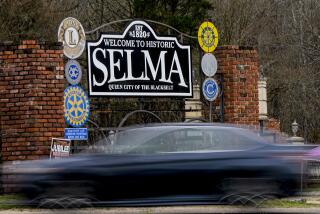Soul-searching
Jena, La., has been portrayed by big-city reporters, who swarmed to the small town Thursday when it became the center of a racial protest, as a place caught in a time warp. African Americans, who make up about 12% of the town’s population of 3,000, live in their own neighborhood, are buried in their own cemetery and reportedly can’t even get their hair cut at the white barbershop. The Revs. Al Sharpton and Jesse Jackson have likened Jena to Selma, Ala., which became a national symbol of Jim Crow repression in the 1960s.
Many white residents, meanwhile, find such criticism bewildering. To them, Jena is just a pleasant, friendly place to live and work. They say everything would be fine if all the media and outside protesters -- agitators, they would have been called in a not-so-bygone day -- would just clear out and leave them alone.
The reality is probably somewhere in between. Jena is no Selma; the uneven treatment accorded to black and white students by school officials and local prosecutors isn’t nearly as overt as the discrimination that racked the South decades ago, when racism was enforced by law as well as custom. It’s highly troubling nonetheless -- and the problems won’t go away when the protesters pack up for home.
Jena became a stewpot of racial tension starting a little more than a year ago, after black high school students sat under a tree that had long been an exclusive gathering spot for whites. Three nooses were found hanging from the branches the following day. It’s hard to imagine a more vicious or provocative symbol in the Deep South, where lynchings of blacks were all too common for nearly a century after the Civil War. The school’s principal wanted to expel the three white students responsible, but the school board ruled the incident a prank and suspended them for just three days. That decision has had terrible consequences.
People of both races have committed violent acts in the year since, but the harshest legal penalties seem to have been reserved for blacks. White youths struck a black student with bottles at a party; only one was charged, with simple battery. The next day, a white man brandished a shotgun at a group of black youths, who wrestled the gun away from him. The gunman wasn’t charged, but the boys were charged with theft for taking his gun. Finally, six black youths beat a white student outside the school gym. Some were initially charged with attempted murder, although the victim was well enough to attend a school ceremony that evening.
Charges against most of the “Jena Six” have rightfully been reduced, but that probably wouldn’t have happened were it not for the media attention and national outrage generated by the case. Jena residents who think all is well in their town are fooling only themselves. Thursday’s rally should mark the start of some long-overdue soul-searching and political housecleaning.
More to Read
Sign up for Essential California
The most important California stories and recommendations in your inbox every morning.
You may occasionally receive promotional content from the Los Angeles Times.










